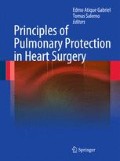Abstract
Ischemic necrosis of a group of cells – infarct – develops if the blood flow is discontinued. The type of circulation of an organ influences the way such cell death occurs. Organs with double circulation, like lungs and bowel, usually resist the closure of one arterial channel, provided the other one is open. Thus, infarcts of these organs occur only when both territories are affected, most frequently due to a global circulatory collapse secondary to heart failure or shock. Anyway, these infarctions are commonly hemorrhagic. The heart has a single circulation with poor collateral branching. Thus, the closure at one point of the arterial tree is enough to cause myocardial infarct, which is usually anemic (“white” infarct).
Access this chapter
Tax calculation will be finalised at checkout
Purchases are for personal use only
References
Torp-Pedersen C, Birk-Madsen E, Pedersen A. The time factor in resuscitation initiated by ambulance drivers. Eur Heart J. 1989;10:555-557.
Jennings RB, Reimer KA. Factors involved in salvaging ischemic myocardium: effect of reperfusion of arterial blood. Circulation. 1983;68:I25-I36.
Antman EM, Hand M, Armstrong PW, et al. 2007 focused update of the ACC/AHA 2004 guidelines for the management of patients with ST-elevation myocardial infarction: a report of the American College of Cardiology/American Heart Association Task Force on Practice Guidelines (Writing Group to Review New Evidence and Update the ACC/AHA 2004 Guidelines for the Management of Patients With ST-Elevation Myocardial Infarction). J Am Coll Cardiol. 2008;51:210-247.
Anderson JL, Adams CD, Antman EM, et al. 2007 guidelines for the management of patients with unstable angina/non-ST-elevation myocardial infarction: a report of the American College of Cardiology/American Heart Association Task Force on Practice Guidelines (Writing Committee to Revise the 2002 Guidelines for the Management of Patients with Unstable Angina/Non-ST-Elevation Myocardial Infarction) developed in collaboration with the American College of Emergency Physicians, the Society for Cardiovascular Angiography and Interventions, and the Society of Thoracic Surgeons endorsed by the American Association of Cardiovascular and Pulmonary Rehabilitation and the Society for Academic Emergency Medicine. J Am Coll Cardiol 2007;50:e1–e157. Erratum in: J Am Coll Cardiol 2008;51:974.
Baroldi G, Bigi R, Cortigiani L. Ultrasound imaging versus morphopathology in cardiovascular diseases. Myocardial cell damage. Cardiovasc Ultrasound. 2005;3:32-39.
Anselmi A, Abbate A, Girola F, et al. Myocardial ischemia, stunning, inflammation, and apoptosis during cardiac surgery: a review of evidence. Eur J Cardiothorac Surg. 2004;25:304-311.
Higuchi ML, Aiello VD, Gutierrez PS. Coração. In: Brasileiro Filho G, ed. Bogliolo – patologia (7 a Edição). Rio de Janeiro: Guanabara Koogan; 2006:408-456.
Jennings RB, Sommers HM, Smyth GA, Flack HA, Linn H. Myocardial necrosis induced by temporary occlusion of a coronary artery in the dog. Arch Pathol. 1960;70:68-78.
Dias AR, Gutierrez PS, Lourenção R, et al. Estudo experimental em cães da ação protetora de solução cardioplégica de lidocaína e potássio. Rev Bras Cir Cardiovasc. 2002;17:79-89.
Murry CE, Jennings RB, Reimer KA. Preconditioning with ischemia: a delay of lethal cell injury in ischemic myocardium. Circulation. 1986;74:1124-1136.
Valen G, Vaage J. Pre- and postconditioning during cardiac surgery. Basic Res Cardiol. 2005;100(3):179-186.
Ferdinandy P, Schulz R, Baxter G. Interaction of cardiovascular risk factors with myocardial ischemia/reperfusion injury, preconditioning and postconditioning. Pharmacol Rev. 2007;59:418-458.
Lopes EA. Aspectos microscópicos e submicroscópicos do infarto do miocárdio experimental em cão submetido a revascularização precoce [thesis]. São Paulo: faculdade de Medicina da Universidade de São Paulo; 1972.
Khabbaz KR, Levitsky S. The impact of surgical and percutaneous coronary revascularization on the cardiac myocyte. World J Surg. 2008;32(3):361-365.
Yellon DM, Hausenloy DJ. Myocardial reperfusion injury. N Engl J Med. 2007;357:1121-1135.
Buja LM, Weerasinghe P. Unresolved issues in myocardial reperfusion injury. Cardiovasc Pathol. 2010;19:29-35
Webb IG, Williams R, Marber MS. Lizard spit and reperfusion injury. J Am Coll Cardiol. 2009;53:511-513.
Laurindo FR, Grinberg M. Campos de Assis RV, Jatene AD, Pileggi F. Perioperative acute myocardial infarction after valve replacement. Am J Cardiol. 1987;59:639-642.
Verma S, Fedak PW, Weisel RD, et al. Off-pump coronary artery bypass surgery: fundamentals for the clinical cardiologist. Circulation. 2004;109:1206-1211.
Balibrea L, Bullon A, DeLa Fuente A, et al. Myocardial ultrastructural changes during extracorporeal circulation with anoxic cardiac arrest and its prevention by coronary perfusion: experimental study. Thorax. 1975;30:371-381.
Suleiman MS, Zacharowski K, Angelini GD. Inflammatory response and cardioprotection during open-heart surgery: the importance of anaesthetics. Br J Pharmacol. 2008;153:21-33.
Wheatley DJ. Protecting the damaged heart during coronary surgery. Heart. 2003;89:367-368.
Kamler M, Wendt D, Pizanis N, Milekhin V, Schade U, Jakob H. Deleterious effects of oxygen during extracorporeal circulation for the microcirculation in vivo. Eur J Cardiothorac Surg. 2004;26:564-570.
Allen BS. The reoxygenation injury: is it clinically important? J Thorac Cardiovasc Surg. 2002;124:16-19.
Gabriel EA, Locali RF, Matsuoka PK, et al. Lung perfusion during cardiac surgery with cardiopulmonary bypass: is it necessary? Interact Cardiovasc Thorac Surg. 2008;7:1089-1095.
Author information
Authors and Affiliations
Corresponding author
Editor information
Editors and Affiliations
Rights and permissions
Copyright information
© 2010 Springer London
About this chapter
Cite this chapter
Gutierrez, P.S., Ishigai, M.M.d.S. (2010). Heart Histopathology in Ischemia-Reperfusion Injury. In: Gabriel, E., Salerno, T. (eds) Principles of Pulmonary Protection in Heart Surgery. Springer, London. https://doi.org/10.1007/978-1-84996-308-4_14
Download citation
DOI: https://doi.org/10.1007/978-1-84996-308-4_14
Published:
Publisher Name: Springer, London
Print ISBN: 978-1-84996-307-7
Online ISBN: 978-1-84996-308-4
eBook Packages: MedicineMedicine (R0)

